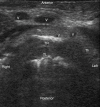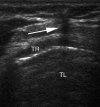Ultrasound-guided percutaneous tracheostomy in critically ill obese patients
- PMID: 22390815
- PMCID: PMC3681363
- DOI: 10.1186/cc11233
Ultrasound-guided percutaneous tracheostomy in critically ill obese patients
Abstract
Introduction: The purpose of this study was to evaluate the feasibility of ultrasound (US)-guided percutaneous tracheostomy (PCT) and the incidence of complications in critically ill, obese patients.
Methods: Fifty consecutive patients were included in a prospective study in two surgical and critical care medicine departments. Obesity was defined as a body mass index (BMI) of at least 30 kg/m². The feasibility of PCT and the incidence of complications were compared in obese patients (n = 26) and non-obese patients (n = 24). Results are expressed as the median (25th-75th percentile) or number (percentage).
Results: The median BMIs were 34 kg/m² (32-38) in the obese patient group and 25 kg/m² (24-28) in the non-obese group (p < 0.001). The median times for tracheostomy were 10 min (8-14) in non-obese patients and 9 min (5-10) in obese-patients (p = 0.1). The overall complication rate was similar in obese and non-obese patient groups (35% vs. 33%, p = 0.92). Most complications were minor (hypotension, desaturation, tracheal cuff puncture and minor bleeding), with no differences between obese and non-obese groups. Bronchoscopic inspection revealed two cases of granuloma (8%) in obese patients. One non-obese patient developed a peristomal skin infection, which was treated with intravenous antibiotics. Ultrasound-guided PCT was possible in all enrolled patients and there were no surgical conversions or deaths.
Conclusions: This study demonstrated that US-guided PCT is feasible in obese patients with a low complication rate. Obesity may not constitute a contra-indication for US-guided PCT. A US examination provides information on cervical anatomy and hence modifies and guides choice of the PCT puncture site.
Trial registration: ClinicalTrials.gov: NCT01502657.
Figures




References
Publication types
MeSH terms
Associated data
LinkOut - more resources
Full Text Sources
Medical

